Family name: Caryophyllaceae Jussieu
Synonym(s): Alsinaceae Bartl., nom. cons.; Dianthaceae Vest; Herniariaceae Martinov; Illecebraceae R. Br., nom. cons.; Paronychiaceae Juss.; Scleranthaceae Bercht. & J. Presl; Silenaceae Bartl.; Spergulaceae Bartl.; Stellariaceae Bercht. & J. Presl; Telephiaceae Martinov
Common name(s): pink family
*Number of genera/species: 97/2,625
List of genera records in GRIN-Global
Fruit usually a denticidaldenticidal:
type of capsular dehiscence, fruit opening by a series of apical teeth
or valvate capsulecapsule:
a dry, dehiscent fruit derived from a compound ovary , sometimes a berry-like fruit (Silene spp.) or a fruit dry at maturity in Pollichia, but fleshy infructescenceinfructescence:
, sometimes a berry-like fruit (Silene spp.) or a fruit dry at maturity in Pollichia, but fleshy infructescenceinfructescence:
mature (fruiting) inflorescence
formed from swollen pedunclespeduncle:
stalk of an inflorescence
appearing like a berryberry:
an indehiscent, fleshy fruit with one or a few to many seeds. The flesh may be homogenous throughout. Or, if the outer part is hard, firm, or leathery, referred to as an hesperidium. Septa are present in some, and the seeds may be arillate or with a fleshy testa. ), or a nutletnutlet:
), or a nutletnutlet:
˜achene
, which sometimes rupture irregularly, 0.4–27 mm long, globoseglobose:
3D shape—more or less spherical to lenticular or trigonoustrigonous:
to lenticular or trigonoustrigonous:
3D shape—having three faces that meet at distinct angles; triangular in outline
, tereteterete:
approximately circular in cross section; width and thickness approximately equal
 in transection, often appearing toothed at apexapex:
in transection, often appearing toothed at apexapex:
the point farthest from the point of attachment, or the "tip" of an organ (because of persistent calyxcalyx:
(because of persistent calyxcalyx:
the outer whorl of the perianth; all the sepals of a flower lobes), rarely winged (Spergula spp.), with one to many seeds. Nutlet enclosed by persistent calyxcalyx:
lobes), rarely winged (Spergula spp.), with one to many seeds. Nutlet enclosed by persistent calyxcalyx:
the outer whorl of the perianth; all the sepals of a flower . Pericarppericarp:
. Pericarppericarp:
fruit wall or fruit coat
black or brown, rarely green or whitish, usually smooth, rarely deeply furrowed (Wilhelmsia). One-seeded spinyspiny:
having slender, stiff, sharp projections oriented in the general plane of the structure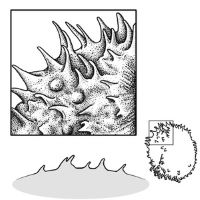 fruit in Sphaero comacoma:
fruit in Sphaero comacoma:
a tuft of hairs, often attached to the tip of seeds
.
Seeds compressedcompressed:
flattened; in grasses, used to denote compression (not necessarily flattened) either laterally or dorsiventrally
, often reniformreniform:
2D or 3D shape—kidney-shaped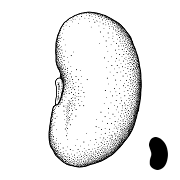 or comma-shaped with radicleradicle:
or comma-shaped with radicleradicle:
the embryonic root of the embryo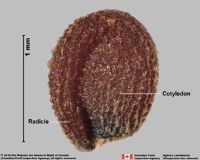 prominent or globoseglobose:
prominent or globoseglobose:
3D shape—more or less spherical to triangulartriangular:
to triangulartriangular:
2D shape—three relatively straight sides with distinct corners; more angular than teardrop-shaped , rarely peltiformpeltiform:
, rarely peltiformpeltiform:
3D shape—shield-shaped
, flattened, compressedcompressed:
flattened; in grasses, used to denote compression (not necessarily flattened) either laterally or dorsiventrally
, or tereteterete:
approximately circular in cross section; width and thickness approximately equal
 in transection, usually 0.4–3 mm long, dustlike in Sagina. Usually unwinged, except in Spergula and Spergularia, which are variable for this trait. Usually exarillate, except funicularfuniculus:
in transection, usually 0.4–3 mm long, dustlike in Sagina. Usually unwinged, except in Spergula and Spergularia, which are variable for this trait. Usually exarillate, except funicularfuniculus:
(alt. funicle) stalk connecting the ovule (later seed) to the ovary (later fruit) placenta arilaril:
arilaril:
(broad sense) appendicular structure that wholly or partly envelops a seed and is produced from or a modification of the funicle, raphe, or outer integument; usually fleshy or pulpy, sometimes spongy or tufted-capillate, often brightly colored in Moehringia and Petrocoptis. Seed coat usually black or brown, crustaceouscrustaceous:
in Moehringia and Petrocoptis. Seed coat usually black or brown, crustaceouscrustaceous:
texture—thin, dry, indurate, and brittle
, shinyshiny:
uniformly reflecting a high proportion of incident light at all angles or dulldull:
or dulldull:
reflecting only a low proportion of incident light, with no apparent sheen , glabrousglabrous:
, glabrousglabrous:
without hairs
, usually sculptured by papilliform cells, rarely smooth, may appear roughenedroughened:
texture—having a small, stout, stiff, more or less acute protrusions
, reticulatereticulate:
surface relief—netted, raised walls or concave grooves forming a net-like surface pattern with flat, concave, or convex interspaces , or tuberculatetuberculate:
, or tuberculatetuberculate:
surface relief—bearing small, warty, swelling, rounded, or variously shaped projections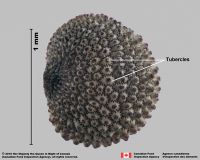 . HilaHilum:
. HilaHilum:
on seeds, the scar indicating where the funiculus was attached; on grass caryopses, the scar visible on the outer fruit surface revealing where the seed is attached on the inner fruit wall surface; or in Asteraceae cypselae, the scar visible on the outer fruit wall revealing where the fruit was attached to the receptacle lateral in notched depression in reniformreniform:
lateral in notched depression in reniformreniform:
2D or 3D shape—kidney-shaped seeds or in the middle of one side in flattened seeds.
seeds or in the middle of one side in flattened seeds.
Embryo two per seed, well developed, completely or nearly filling seed coat, usually peripheralperipheral:
(of embryo) embryo is curved around the outer edge of the seed, near the seed coat
, sometimes axileaxile:
on or of the axis
and centric, foliatefoliate:
appearing leaf-like
(spatulatespatulate:
2D shape—like a spatula; rounded at the apex, with base long and tapered; (of embryo) embryo is straight and axile and centric with the cotyledons expanded to form the shape of a spatula or spoon; (of cotyledons) cotyledons expanded and wider than the stalk but not invested into the stalk ), usually curvedcurved:
), usually curvedcurved:
(of embryo) linear embryo is curved into an arch or horseshoe with the ends far apart (arcuate to circinatecircinate:
(arcuate to circinatecircinate:
3D shape—terete and rolled downward from the apex in a tight coil
), rarely straight (Dianthus).
Endosperm scanty or absent. Perispermperisperm:
seed nutritive tissue comparable to the endosperm, but derived from the nucellus (maternal tissue)
copious to moderate, mealymealy:
loose, dry, and disintegrating in finely granular
pieces like meal or flour
or horny.
Can be a common upland weed. It usually forms dense clumps or predominant populations in waste places or upland fields. It spreads by seed reproduction.
Noxious Weed: USA Federal Noxious Weed List, terrestrial, Drymaria arenarioides Humb. & Bonpl. ex Schult.
| Fruit | |
| Type | capsulecapsule: a dry, dehiscent fruit derived from a compound ovary  , berrylike, nutletnutlet: , berrylike, nutletnutlet:˜achene |
| Size range | 0.4–27 mm long |
| Shape(s) | globoseglobose: 3D shape—more or less spherical  , ellipsoidellipsoid: , ellipsoidellipsoid:3D shape—elliptic , oblongoblong: 2D shape—much longer than broad with nearly parallel sides, corners are rounded  , ovoidovoid: , ovoidovoid:3D shape—ovate  , clavateclavate: , clavateclavate:3D shape—club-shaped, with attachment at or near narrow end (compare obclavate) 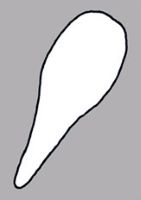 , cylindricalcylindrical: , cylindricalcylindrical:3D shape—a cylinder, with parallel sides and a circular cross-section; tubular or rod-shaped , lobed, conicalconical: 3D shape—cone-shaped, with the point of attachment at the broad end 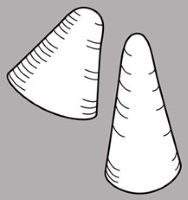 , lenticularlenticular: , lenticularlenticular:3D shape—lens-shaped; biconvex 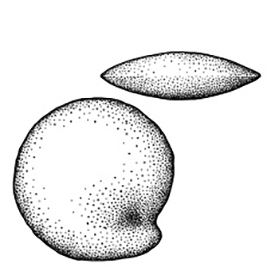 , urceolateurceolate: , urceolateurceolate:3D shape—urn-shaped, hollow and contracted near the apex |
| Texture | chartaceouschartaceous: papery, papyraceous , membranousmembranous: texture—extremely thin, pliable, and fairly tough , scariousscarious: texture—dry, thin, membranous, non-green, more or less translucent , sometimes inflated and somewhat fleshy (Wilhelmsia) |
| Surface relief | smooth, rarely furrowed or papillatepapillate: surface relief—bearing minute, distinct, broad-based projections, tapering to a rounded apex  |
| Color(s) | black, brown, white |
| Unique features | Black or brown, small, denticidaldenticidal: type of capsular dehiscence, fruit opening by a series of apical teeth capsulescapsule: a dry, dehiscent fruit derived from a compound ovary  usually with numerous dark, crustaceouscrustaceous: usually with numerous dark, crustaceouscrustaceous:texture—thin, dry, indurate, and brittle , sculptured reniformreniform: 2D or 3D shape—kidney-shaped  seeds. Sometimes one-seeded nutletsnutlet: seeds. Sometimes one-seeded nutletsnutlet:˜achene enclosed by persistent calycescalyx: the outer whorl of the perianth; all the sepals of a flower  . . |
| Seed | |
| Size range | 0.4–3 mm long, dustlike in Sagina |
| Shape(s) | often reniformreniform: 2D or 3D shape—kidney-shaped  or comma-shaped with radicleradicle: or comma-shaped with radicleradicle:the embryonic root of the embryo  prominent or globoseglobose: prominent or globoseglobose:3D shape—more or less spherical  to triangulartriangular: to triangulartriangular:2D shape—three relatively straight sides with distinct corners; more angular than teardrop-shaped  , rarely peltiformpeltiform: , rarely peltiformpeltiform:3D shape—shield-shaped |
| Surface relief | papillatepapillate: surface relief—bearing minute, distinct, broad-based projections, tapering to a rounded apex  to tuberculatetuberculate: to tuberculatetuberculate:surface relief—bearing small, warty, swelling, rounded, or variously shaped projections  (sometimes appearing starlike), roughenedroughened: (sometimes appearing starlike), roughenedroughened:texture—having a small, stout, stiff, more or less acute protrusions , reticulatereticulate: surface relief—netted, raised walls or concave grooves forming a net-like surface pattern with flat, concave, or convex interspaces  , rarely smooth , rarely smooth |
| Color(s) | black, brown, rarely straw-colored, sometimes dark red to red-brown, gray-black, whitish, or translucenttranslucent: transmitting light uniformly and diffusely 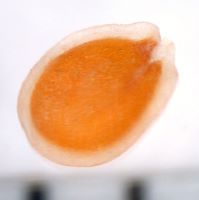 |
| Unique features | Usually dark colored, papillatepapillate: surface relief—bearing minute, distinct, broad-based projections, tapering to a rounded apex  reniform or comma-like seeds with a prominent radicleradicle: reniform or comma-like seeds with a prominent radicleradicle:the embryonic root of the embryo  with embryos (two per seed) visibly curvedcurved: with embryos (two per seed) visibly curvedcurved:(of embryo) linear embryo is curved into an arch or horseshoe with the ends far apart  to coiledcoiled: to coiledcoiled:(of embryo) linear embryo is very long and bent to form a coil whereby one end of the embryo is on the outside and the other end near the middle of the seed 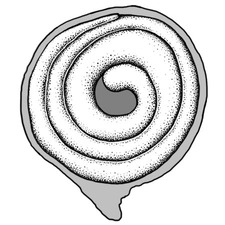 around copious to moderate, mealymealy: around copious to moderate, mealymealy:loose, dry, and disintegrating in finely granular pieces like meal or flour or horny perispermperisperm: seed nutritive tissue comparable to the endosperm, but derived from the nucellus (maternal tissue) . Seeds with larger laterallateral: (of embryo) embryo lies along the side of the seed, generally towards one end; of, at, or from the side; in grasses, can refer to the sides adjacent to the dorsal and ventral sides hilahilum: on seeds, the scar indicating where the funiculus was attached; on grass caryopses, the scar visible on the outer fruit surface revealing where the seed is attached on the inner fruit wall surface; or in Asteraceae cypselae, the scar visible on the outer fruit wall revealing where the fruit was attached to the receptacle  . . |
| Other | |
| Embryo | two per seed, well developed, completely or nearly filling seed coat, usually peripheralperipheral: (of embryo) embryo is curved around the outer edge of the seed, near the seed coat , sometimes axileaxile: on or of the axis and centric, foliatefoliate: appearing leaf-like (spatulatespatulate: 2D shape—like a spatula; rounded at the apex, with base long and tapered; (of embryo) embryo is straight and axile and centric with the cotyledons expanded to form the shape of a spatula or spoon; (of cotyledons) cotyledons expanded and wider than the stalk but not invested into the stalk  ), usually curvedcurved: ), usually curvedcurved:(of embryo) linear embryo is curved into an arch or horseshoe with the ends far apart  (arcuate to circinatecircinate: (arcuate to circinatecircinate:3D shape—terete and rolled downward from the apex in a tight coil ), rarely straight (Dianthus) |
| Nutritive tissue | Endosperm thin or absent. Perispermperisperm: seed nutritive tissue comparable to the endosperm, but derived from the nucellus (maternal tissue) copious to moderate, mealymealy: loose, dry, and disintegrating in finely granular pieces like meal or flour or horny. |
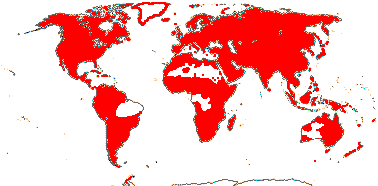
Distribution map courtesy of Angiosperm Phylogeny Website.
Kirkbride et al. 2006Kirkbride et al. 2006:
Kirkbride JH, Jr, Gunn CR, and Dallwitz MJ. 2006. Family guide for fruits and seeds, vers. 1.0. Accessed September 2020-January 2022. URL: https://nt.ars-grin.gov/seedsfruits/keys/frsdfam/index.cfm .; Kubitzki et al. 1990+Kubitzki et al. 1990+:
Kubitzki K et al., eds. 1990+. The families and genera of vascular plants. 7+ vols. Berlin etc.; Noxious Weed Regulations 2020Noxious Weed Regulations 2020:
Noxious Weed Regulations. 2020. 7 C.F.R. sect; 360.100-360.600.; Takhtajan 2009Takhtajan 2009:
Takhtajan A. 2009. Flowering plants: Second edition. Springer Nature, Switzerland. 871 pp.; USDA 1980USDA 1980:
United States Dept. of Agriculture (USDA). 1980. Major weed family identification guide. Hyattsville Md, United States ; Zhengyi et al. 2004+Zhengyi et al. 2004+:
Zhengyi W, Raven PH, and Deyuan H. 2004+. Flora of China [online]. 25 vols. Science Press, Beijing China & Missouri Botanical Garden, St. Louis USA. Accessed January–March 2024. http://flora.huh.harvard.edu/china/
*The number of genera and species is based on Christenhusz and Byng 2016Christenhusz and Byng 2016:
Christenhusz MJM and Byng JW. 2016. The number of known plant species in the world and its annual increase. Phytotaxa 261 (3): 201-217. https://doi.org/10.11646/phytotaxa.261.3.1, which may differ from the number of genera in GRIN-Global.